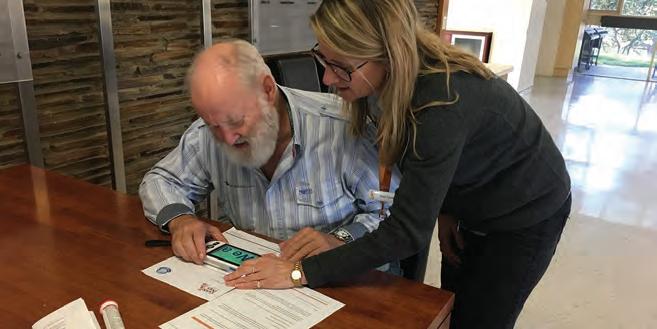
4 minute read
ORTHOPTICS AUSTRALIA
by Prime Group
MORE THAN GUIDE DOGS
GUIDE DOGS’ SERVICES EXTEND BEYOND WHAT ITS NAME SUGGESTS, TO ALSO INCLUDE ORTHOPTIC SERVICES. ORTHOPTIST KATE CLARK DESCRIBES THE DIFFERENCE SHE HAS MADE IN ONE CLIENT’S LIFE.
KATE CLARK
"CHRIS (CLIENT) EXPLAINED THAT HE OFTEN HAD TO WAIT FOR A WEEK FOR SOMEONE TO VISIT TO ASSIST HIM TO READ HIS MAIL" F or more than 60 years Guide Dogs has provided vital support for people with low vision or blindness.
Since then, Guide Dogs’ services have expanded far beyond just Guide Dogs, to helping people with low vison or blindness move with confidence, achieve the ordinary and the extraordinary, connect with their community and feel better physically and emotionally – no matter their level of vision.
In fact, despite being best known for its much-loved namesake, more than 70% of the supports and services offered by Guide Dogs are non-dog related.
Guide Dogs supports people with low vision or blindness at every stage of their journey, through a variety of services that can be adapted to meet individual needs.
Clients come to Guide Dogs Victoria wanting to explore new services that will help reach their individual goals, ranging from orthoptic services, technology solutions, occupational therapy, peer support, and cane and guide dog training.
GUIDE DOGS VIC ORTHOPTIC SERVICES Orthoptists are often the first port of call for Guide Dogs Victoria clients, using our knowledge, training and experience to provide tailored low vision supports to people of all ages.
An orthoptic functional vision assessment can provide clients, family members, friends, carers, and other health professionals with valuable information about a person's remaining vision. This can be particularly helpful for those who are very young, non-verbal or have additional disabilities.
I am one of Guide Dogs Victoria’s low vision orthoptists. I work with clients of all ages and find the work exciting and extremely rewarding, in this ever-evolving field of orthoptic practice. Increasing independence and quality of life for clients is at the forefront of every service we provide.
In low vision orthoptic practice no two days are the same. Every person is different, their vision, their personality, lifestyle and low vision goals. Every day I meet new people and have the privilege and opportunity to contribute to their daily independence and quality of life.
Guide Dogs Victoria specialist Kate Clark with client Chris who has low vision.
An important part of our practice includes keeping up to date with changes in low vision aids and assistive technology (including accessibility options for mainstream devices) and availability and changes in individualised funding. This is vital as these are constantly evolving and being knowledgeable allows us to provide clients with the most suitable and up to date options.
CHRIS' STORY Some of my recent work has involved working with Guide Dogs Client chris who is living with severe low vision. Prior to working with him, Chris was unable to read any form of hard copy print which greatly affected his independence.
Chris explained that he often had to wait for a week for someone to visit to assist him to read his mail. "My independence was heavily impacted by the changes to my vision,” he said.
“I found it difficult to perform even the simplest reading tasks like reading my mail from the council or food packaging and expiry dates. Being able to read was so important to retaining my quality of life and staying active but I needed assistance to find the right product available to assist me.” To understand Chris' level of functional vision, I conducted an assessment to help to determine: • What he could see and how best to utilise his remaining vision. • What strategies and low vision aids
would best help him with his goals. • How best Chris could manage visual fatigue when reading or conducting tasks.
The assessment results enabled me to recommend the best strategies and low vision aids to help Chris achieve his goals, such as reading his mail, identifying food expiry dates and reading menus when eating out. For Chris, a small, portable electronic magnifier was recommended.
Chris was both delighted and very emotional saying: "This magnifier is going to make a world of difference to me. I can read my mail again without waiting a week for someone to read it to me and not paying bills because I don't know when they are due. "I will be able to know what I am buying at the shops instead of coming home with the wrong products. I can even go to the library and sit and read the newspaper if I want. I would never have dreamed I could do that.”
To know more about Guide Dogs' services, visit www.guidedogs.com.au n
ABOUT THE AUTHOR: KATE CLARK is a Guide Dogs Victoria specialist who has worked in low vision for eight years after many years in clinical practice. She works with clients of all ages to provide orthoptic services to people with low vision or blindness.
ORTHOPTICS AUSTRALIA strives for excellence in eye health care by promoting and advancing the discipline of orthoptics and by improving eye health care for patients in public hospitals, ophthalmology practices, and the wider community. Visit: orthoptics.org.au






